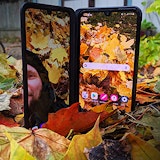
The LG G4 has a lot to live up to. Last year, LG surprised the mobile industry with its popularly-received G3. It had a great camera, fun UI, an impressively compact design despite its large display, and was one of the first phones on the market to feature a quad-HD (2560 x 1440) resolution.
Since then, reviewers have been asking the question: was this a line in the sand, or a one-off wonder?
The G4 has provided us with a resounding answer: 2014 was no fluke. LG has done it again, releasing one of the best phones on the market in 2015.
All leathered up

Globally, there are three design options for the G4. You can get it with a rear panel made of plastic, ceramic or genuine leather. The first two come printed in an unfortunate diamond pattern that looks like a cheap blingy cover you might grab on Ebay, but the leather backing is something else, even if it doesn’t quite feel like it at first.
Before you ask: yes, it is real leather. Each panel takes around three months to fully complete. The leather itself is “skived” down to just 0.45mm, which has the unfortunate side-effect of making it feel a little bit like the plastic. As such the first impression is a little disappointing, but the longer you use it the more its benefits become clear.

As a material, leather provides great grip without feeling cheap like the ‘soft-touch’ materials of yesteryear. It’s also surprisingly protective. A drop that might make you gasp in horror with another phone provides a harmless dull ‘thud’, as the G4 calmly impacts its resting place and comes to a restful stop.

An added benefit is that leather ends up looking better the longer you have it, so any wear and tear on the G4 should end adding character. Although there is reportedly such a thing as too much personality.
Just be careful if you’re cooking in the kitchen. Oil stains are a danger, as is anything else you’d normally want to keep away from a fancy leather bag or pair of shoes.
As for pricing, the leather back is a little more expensive as an option, but it’s worth it. The ceramic back isn’t available in many markets, and the plastic is far too slippery in the hand for our tastes. Plus, if you buy the leather, you’ll get a plastic back inside the box, too. Just in case you’re in the mood to switch things up.
Only the brown and black rear panels are available as a default case, but eventually you should be able to buy the burgundy, yellow, pink, orange and blue cases as optional accessories, if you can’t already.
Design

In terms of general build design, the LG G4 is exceptional. Like the G3, its large 5.5 inch screen makes little impact on the overall size of the device thanks to super-thin bezels. As a measure for comparison, the iPhone 6 Plus has the same-sized screen (with a lower resolution), but the G4 is almost a full 1cm shorter from bottom to top.
The rear-mounted volume and lock buttons may give pause, but allow them time to win you over. Not only are they great for lefties and righties alike, but once you acquire the muscle memory it’s probably the most elegant solution around. If you’re worried about accessing your phone while it’s sitting flat on a table, don’t. Double-tapping the screen serves to both wake it up and lock it as well.

The aforementioned slim bezels make for a device that is easy to hold, despite its larger screen. Thanks to the button placement there’s little-to-no finger gymnastics required, and if you go for the leather back that’s just one more element of grip adding to your stress-free experience.
Of course, nothing is perfect. The plastic rim of the G4 does detract somewhat. When paired with the plastic rear panel, the G4 retains its intelligent build but the premium feel is totally gone. Even with the leather option it’s a weak spot. A metal rim would be great to see here, but considering the thought put in to the rest of the design we’ll allow the G4 this one misstep.
Display and User Experience

We’re finally nearing the point where talking about screen quality on a smartphone may become a thing of the past. The G4, like many other phones on the market, rocks a truly impressive display with almost no flaws. It’s bright, colourful, manages quite inky blacks and pure whites, and rocks a super-crisp quad-HD (1440 x 2560) resolution.
Could the black elements be blacker and the white ones whiter? Yes. Could it be a little more visible in direct sunlight? Of course. These are obstacles that no screen manufacturer has overcome, but they’re also non-issues the vast majority of the time. The moral of the story is that modern smartphone screens are incredible; the LG G4 is no exception.

On that note, the G4 does have one little display trick up its sleeve; it’s ever-so-slightly curved. This is not a flexible display like the LG G Flex or Flex 2, so don’t go pressing the G4 flat on any tables as a party trick. The curve has one major purpose: durability. LG claims that this curve increases the screen’s strength by no less than 20%, which can easily be the difference between a trip to the repair shop and just another time you fumbled your phone.
The curve also helps the G4 conform a little more closely to the shape of your leg, making it a better fit in tight pockets.
As for the user interface (UI), LG has gone with the same highly customisable experience that we fell in love with on the G3. The lock screen has five icon spaces, in to which you can place any app. A tap and swipe up from any of these icons causes immediate launch. Unlike on the G3, the G4 does this quite quickly, although at times there can still be a noticeable delay.

Double-tapping the volume-down button will launch the camera and automatically take a picture. This is not only a great way to take a fast pic, it also frees up one of those useful icon spaces which may have otherwise been taken up by your camera app.
On the home screen, the grid layout is 5x5, rather than the more-common 4x4 or 4x5. This allows you to fit significantly more icons on each screen, which is great for folk that use a wide range of apps and services.

Perhaps the best bit of LG’s UI is the custom arrangement of the default virtual on-screen buttons. You can move around the back, home and multitasking keys in to whatever arrangement you want. This is useful, but not nearly as much as adding a notification tray button to the mix.
Performance and battery life

Where the G3 could be painfully laggy at times, the G4 generally offers a smooth experience. It’s not quite as responsive as a vanilla Android UI would be, and it does have the odd little moment’s delay, but it’s generally no slower than a Galaxy S6 or HTC One M9.
Heating is just not an issue. Where other phones, its predecessor included, can get pretty darn hot when pushed with games like Plants vs Zombies 2 or Hearthstone, the G4 seems oddly immune to such issues.
Battery life leaves a little to be desired. For medium-to-heavy use it’ll easily last a day, but push it hard with the aforementioned games or heavy video streaming and you’ll be looking for an outlet before bed time. We’d like to have seen more here, but ultimately G4 charge life was within modern standards.
Camera
This is a huge strong point for the G4. The camera takes great photos during the day and great ones at night. This would be in our top 3 cameras on the market, sitting right alongside the Samsung Galaxy S6 and the Apple iPhone 6 Plus.
Shots during the day are crisp and clear. Colour is accurate and doesn’t suffer from over-saturation, which is still a common problem.
Night shots come out very well compared to other phone models. They’re still far from perfect, but that’s a limit of all current flagships. At the very least, the G4 manages to obtain focus and capture a relatively clear photo with mostly-accurate colours, even when the target is in extreme motion.
This image of a performer at a recent LG OLED event demonstrates this well. You might be tempted to pick out the flaws, such as the pixel noise, but point any other camera on the market at this same spectacle and you’d likely end up with a fuzzy blur where the light batons were spinning, a whole heap of bleeding from the LED suit, and little else. Not impressive enough? This was taken using burst mode; it’s just one of 11 taken over a couple of seconds.
One minor gripe would be the G4’s occasional tendency towards over-warming night shots. Often, they come out a little on the yellow side of the spectrum. However, its ability to generate an image with both bright lights and dark elements with minimal light bleeding is impressive enough to make up for it. This goes doubly for when HDR automatically kicks in, such as with the image below.
All of these examples have been taken on auto mode, but LG has also included a fantastic manual settings menu for the more-advanced user. You can easily adjust white balance, focus, ISO, shutter speed and exposure. You can even switch between saving as a JPEG, or as a raw DNG file. This later file type is preferable if you’re planning of editing your images on a desktop or laptop, but they tend to take up about 19MB per photo, as opposed to the roughly 5MB of a JPEG.
Taking advantage of manual mode helps to fix the warmth issue with night shots, but is generally not necessary. The auto settings are good enough that the majority of users will probably end up dabbling with manual mode for the novelty, but eventually leaning back and letting the phone do all the work for you.
Verdict

The LG G4 is a fantastic phone. Its camera is its strongest point, followed closely by its intelligent build. It really is far easier to grip and use than any other 5.5 inch phone on the market. The rear-mounted buttons, complimented by the tap-on/tap-off screen functionality, make it a comfortable experience for both lefties and righties alike.
The plastic back option leaves a little to be desired, but considering how much we loved the utility of the leather case, as well as the fact that you get a free plastic back with a leather model purchase, then there’s not much to complain about.

Weak points are battery life and the occasional lag we experienced. While neither was really what we could justifiable label as a ‘flaw’, we’d like to see our flagship devices keep charge for longer than ‘about’ a day, and with the kind of power the G4 rocks under the hood any lag is too much.
At the end of the day we were thoroughly pleased with LG’s showing here. That makes it two years in a row that LG has managed to hit it out of the park. By the looks of things, we can expect this trend to continue well in to the future.
Android finally has another regular top-contender, joining the ranks of Samsung, HTC and Motorola. If you’re after a top-tier Android, the LG G4 is definitely worth your consideration alongside the until-now uncontested champion: the (flat) Samsung Galaxy S6.
Related Articles
Find Better Phones and Plans
Hundreds of cell phone plans unpacked. All the facts. No surprises.






































